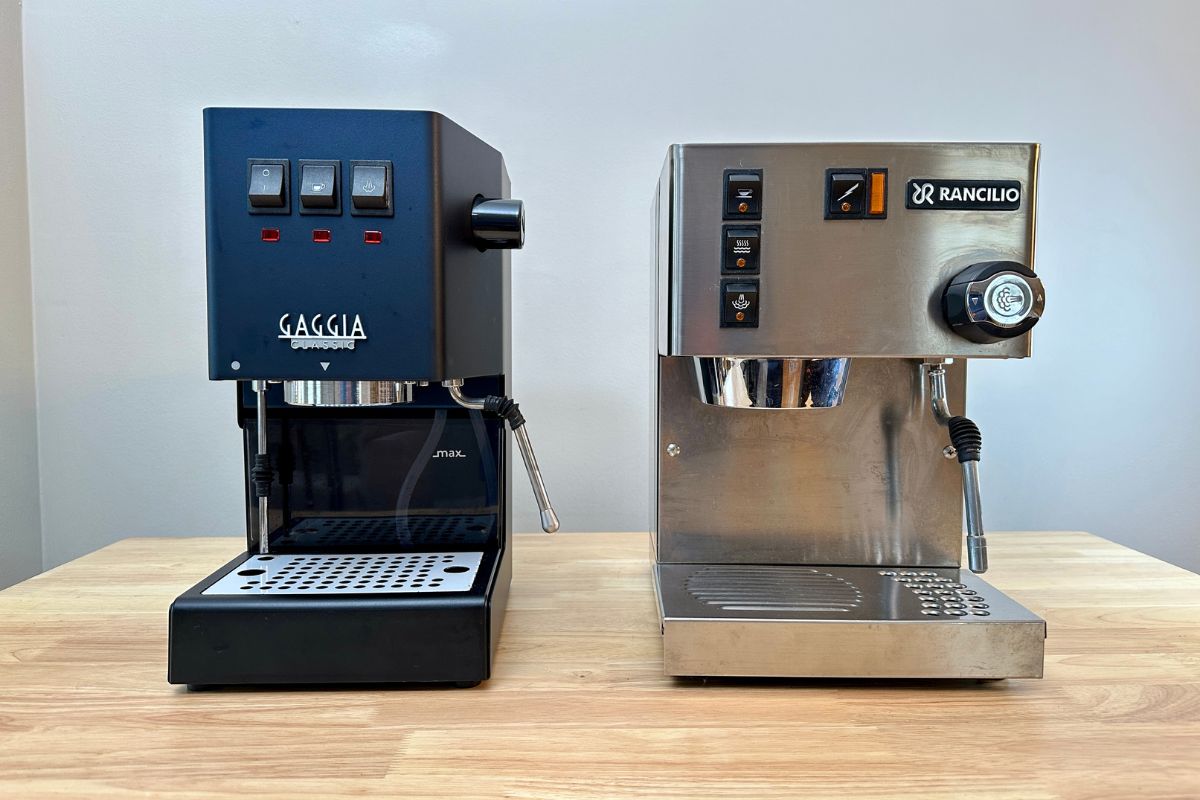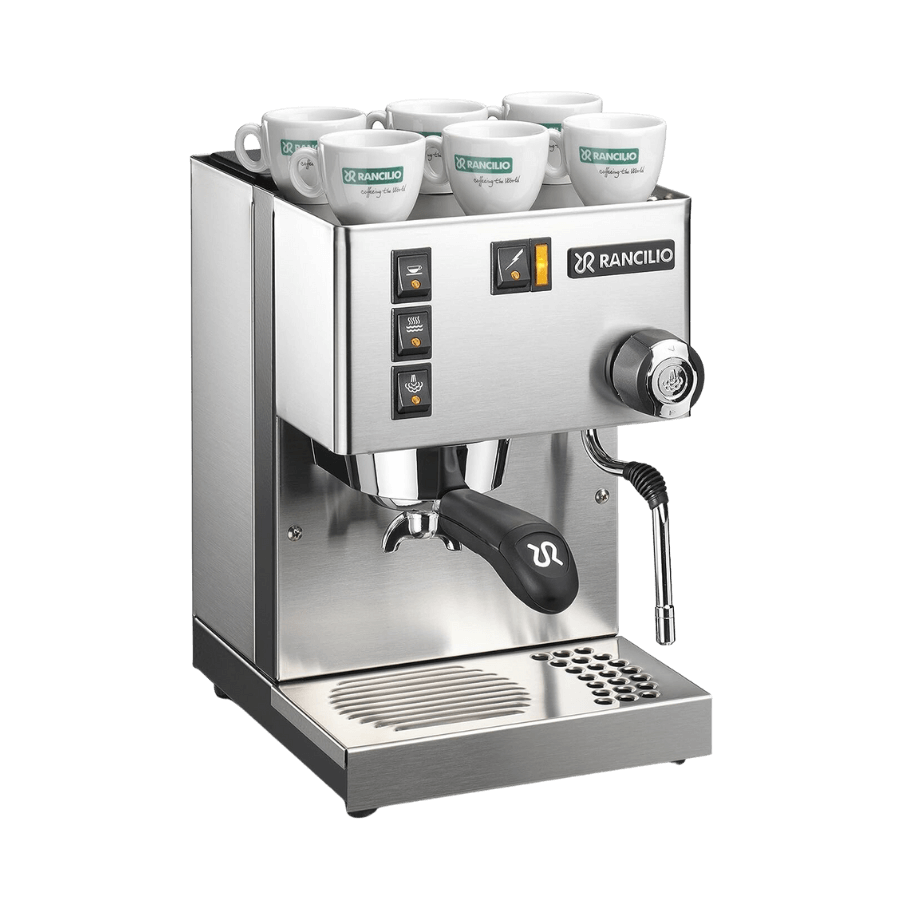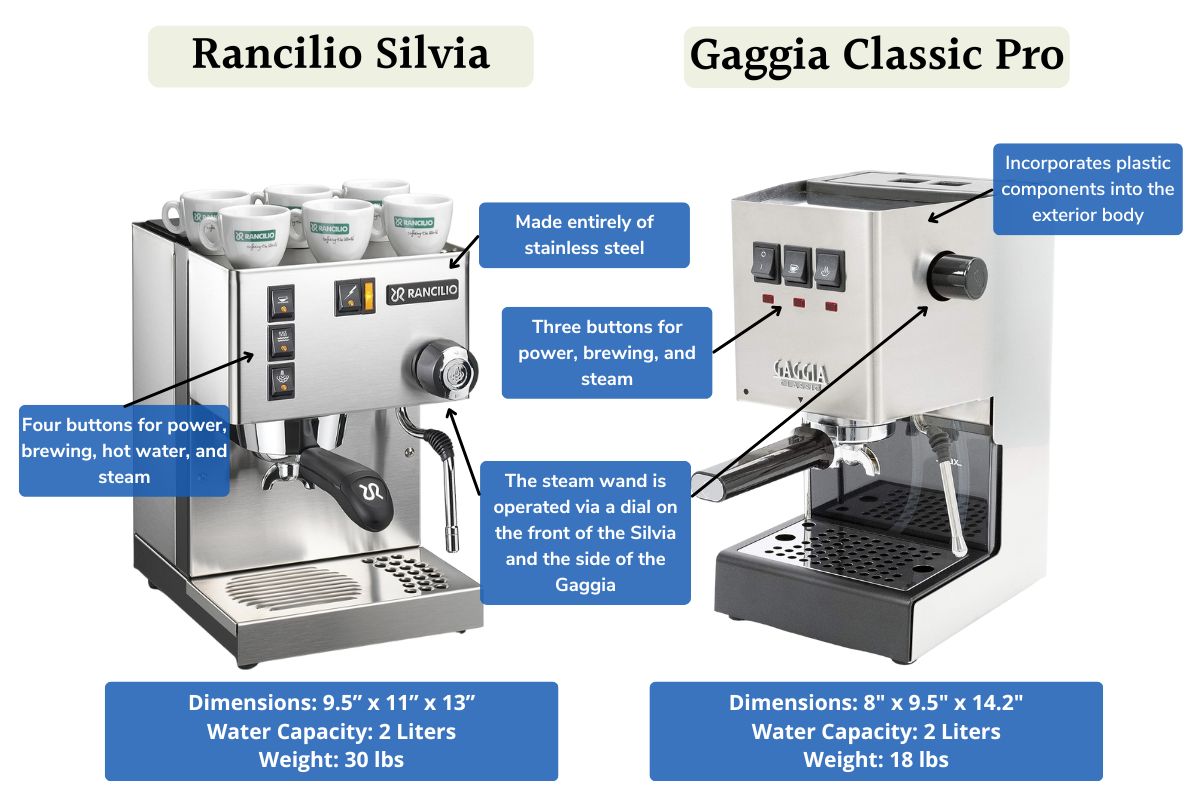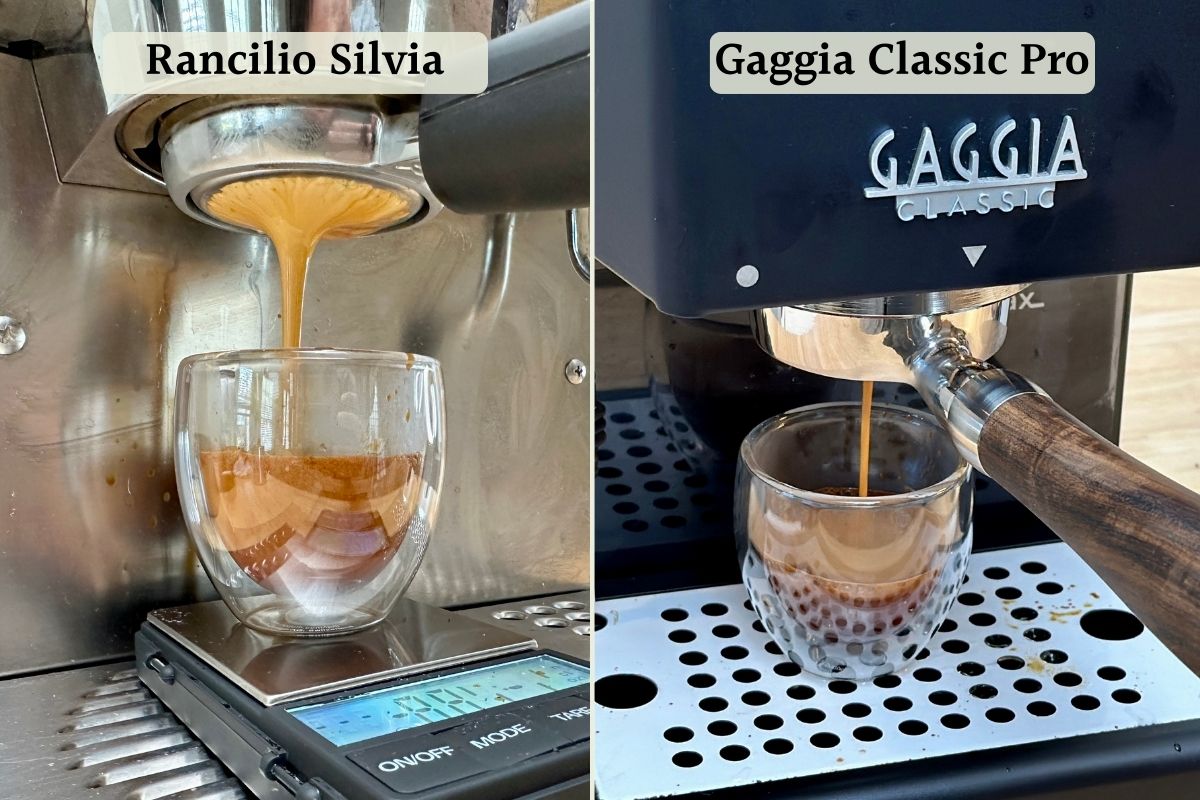
For simple home espresso, two machines instantly attract attention for their value and ease of use: the Gaggia Classic Pro and the Rancilio Silvia. How do they compare?
I recommend the Rancilio Silvia, as the bigger boiler has better temperature stability, which leads to better espresso and steamed milk. While the Silvia is more expensive, it will last a long time (and I do mean a long time). The Gaggia Classic Pro is still a solid, budget-friendly option, but brew temperature is less consistent, and it’s harder to use.
I’ve used both and will compare the Gaggia Classic Pro vs Rancilio Silvia. The boiler really separates these two, and I’ll also mention some important nuances to consider.
Note: the Gaggia Classic has been redesigned as the “Evo” classic that operates at nine bars. This is an overdue change that makes it more competitive.


Design and Build

The basic construction of both the Rancilio Silvia and the Gaggia Classic Pro looks similar at first glance. Each machine has the same boxy design and simple user interface. There are some important differences once you take a closer look, however.
The Gaggia Classic Pro is slightly thinner, so it takes up a little less space than Silvia. It’s not much – only about 3” – but that can be a big deal if you’re tight on counter space. The Gaggia is also slightly taller. The narrowness will help when fitting a grinder, and I like the Gaggia look more.
The Silvia is significantly heavier than the Gaggia Classic Pro. The Gaggia weighs only about 18 lbs., but the Silvia is 30 lbs.! Most of that is because of the Silvia’s sturdier build. The Silvia is made entirely of stainless steel. That steel build is a reminder that Rancilio is best known for its commercial coffee equipment. In fact, the Sivlia feels like a commercial espresso machine packaged in a home machine size.
The same design that makes the Silvia so heavy is also what makes it durable. The Silvia is meant to be used for years, and it’s not uncommon to find Silvia users who have had their machine for a decade or more. Actually, the model I tested was loaned by a friend who bought it second-hand. And it runs great 🙂
By contrast, the Gaggia Classic Pro feels like an entry-level option. You can still find plenty of old GCPs that work really well, and it uses standard components that are easy to replace. However, Gaggia incorporates plastic into the exterior body.
Build quality aside, each interface is similar. The Gaggia Classic Pro has three buttons versus Silvia’s four, which include a hot water function. The steam wand is operated via a dial on the front of the Silvia and the side of the Gaggia. It’s pretty obvious to use an on/off switch for power, brewing, and steaming, and you’ve basically learned how to work the other by learning one.
Heating System and Espresso Performance

Both the Rancilio Silvia and Gaggia Classic Pro are single-boiler espresso machines. Neither can brew and steam at the same time, and neither includes a PID system. It seems they’d perform similarly, but the devil is in the details.
To start, the Silvia’s boiler is significantly larger than the Gaggia’s – 300 mL to 130 mL. This is a double-edged sword. It means that the Silvia takes a lot longer to heat up than the Gaggia. You should wait 10-20 minutes for the Silvia to start and 1-2 minutes between brewing and steaming.
That delay is annoying in the morning, and you may suffer from cold shots or settled milk while you wait for the boiler on the Silvia to move from one setting to the other.
Once it reaches the target temp, the Rancilio Silvia has excellent temperature stability.
The Gaggia Classic Pro’s smaller boiler is quick(er) to heat up and switch modes. The smaller boiler takes less energy to heat, so it’s ready to start in 5 minutes, and you can transition from brewing to steaming in one minute.
The problem is the Gaggia Evo Classic Pro is prone to temperature fluctuations and instabilities. You’re never 100% sure that your shots are pulling at the same temperature every time since there’s no PID. This means that you resort to “temperature surfing” to program the perfect brew temperature by manually manipulating the boiler.
Essentially, purge some water if you think it’s too hot, and wait a minute if it’s too cold. Temperature surfing is gut feel, and after using the GCP for a while, I found waiting 5 minutes to heat, purging water for 10 seconds, then going through puck prep is the best “surfing” method.
The small boiler lets you make quick changes, including your own temperature profile by purging. Once you get the hang of manipulating the temperature manually, you can get more precise control through temperature surfing than you can on the Silvia, even without a PID.
The other big difference between the two machines (or what used to be) is the pressure. The Silvia has a great OPV that provides a consistent 9 bars of pressure on every shot.
The Gaggia Classic Pro has historically run at 12 bars, as the OPV couldn’t meter down the 15-bar pump pressure by the time the water reached the brew head.
I installed a 9-bar spring on my Gaggia to reduce the pressure, which leads to a much more balanced taste with a slower flow.
New models, called the Gaggia Classic Evo Pro, achieve a consistent 9 bars right out of the box. This is a long over due change that makes much better espresso. Make sure to get a Gaggia “Evo” model.
Overall, the Rancilio Silvia brews better espresso than the Gaggia Evo Classic Pro because of the larger boiler. My espresso tastes smoother and balanced on the Silvia, with a nicer acidity and cleaner flavor notes without harshness.
Meanwhile, the Gaggia Classic was comparable, but I often got astringency from an overheated boiler. I could just as easily get a dull taste if I purged the boiler too long.
A bigger boiler will win every time, which is why you pay more for the Rancilio Silvia.
Steam Wand and Milk Frothing

The steam wand on the Rancilio Silvia reminds me of Rancilio’s experience with commercial machines. The large boiler provides high steam pressure to texture your milk. You’ll get good aeration from the wand tip.
The steam wand on the Gaggia Classic Pro is less powerful and, in my opinion, sub-optimal. The smaller boiler of the Gaggia creates less steam pressure, so it takes longer to heat and texture milk. I’m not a fan, but some espresso beginners may find this lower pressure less intimidating than the Silvia.
The real problem with the Gaggia steam wand is the design of the tip. The holes where steam is released are at an angle. That’s not very conducive to evenly introducing air into your milk.
The holes on the tip of the Gaggia steam wand point more sideways than downward. This can make it difficult to control how air is incorporated into the milk, which is the chief factor that determines milk texture. It also makes for more bubbling and churning in the milk, rather than the desired whirlpool.
In an ideal setup, steam is forced out at a downward angle so that it’s easy to control the introduction of air and produce a whirlpool motion in the milk. The vortex is key to a nice microfoam.
Both machines, however, have a steep learning curve for using the steam wand. They may be entry-level espresso machines, but the steam wands are fully manual.
There’s no automatic shutoff, machine-assisted texturing, or programmable steaming. If you want to get good milk for a latte or cappuccino, you have to learn how to do it manually. Counterintuitively, the more powerful Rancilio Silvia is actually easier to use because of the higher pressure, although it is scary for beginners!
Ease of Use and Accessories
The interfaces of the Rancilio Silvia and Gaggia Classic Pro look similar, but the Silvia has a few quality-of-life improvements that make it much easier and more convenient to use.
The starkest difference between the two machines is in the portafilter. Both machines use the same portafilter size – 58mm. The Gaggia Classic Pro’s portafilter is functional, if basic. It has a cheap-feeling plastic handle that doesn’t feel great to use, but it gets the job done.
Silvia’s portafilter is sturdy and feels hefty, much like the rest of the machine. It’s also designed so that when you set the portafilter down on the counter, the basket is parallel to the ground and sits perfectly flat. This is meant to make tamping both easy and consistent, which is a welcome design feature.

While we’re on the subject of tamping, the Silvia easily outclasses the Gaggia Classic Pro in its included tamper. The Silvia’s tamper is commercial grade, with a metal head and wooden handle.
The Gaggia’s tamper is flimsy plastic that will need replacing almost immediately. In fact, if you do order the Classic Pro, go ahead and buy a professional 58mm tamp in the same purchase (I use this portafilter and tamper).
The Gaggia does come with two sets of portafilter baskets: a pressurized and non-pressurized single and double basket. By contrast, the Silvia only comes with a non-pressurized single and double basket.
This seems to be a point for the Classic Pro, but it’s not that simple. Like the rest of the machine, the build quality on Silvia’s baskets is commercial grade.
The Classic Pro’s baskets are functional, though. I don’t like the tapered sides, but I didn’t notice much when I upgraded to an IMS basket. You can grind finer, but it’s not THAT different. I mostly didn’t feel like the GCP baskets were built with the same attention to detail and precision as the Silvia’s.
Value
A quick look at the price of each machine will tell you that the Gaggia Classic Pro is much cheaper than the Rancilio Silvia. The Gaggia retails for under $500 and costs less than the Silvia.
Figuring out which is the better value is a little more complicated than just what the price tag says. While both machines function basically the same, they serve very different purposes in the home barista journey.
The Gaggia is a great entry-level machine that most aspiring coffee aficionados will use as an affordable step on the way to a better machine. It gets the job done, but its accessories feel cheap, it only uses a single boiler, and it doesn’t even have a hot water tap. It makes for a budget-friendly start to home espresso, but you’ll eventually want to save for an upgrade.
The Silvia is meant to last you a while for someone who wants high-quality espresso. It’s not designed to be a segue to a machine upgrade. Instead, it’s meant for someone who’s happy with a simple machine setup and limited functionality and needs a sturdy espresso machine they can trust to last. Considering that some Silvia machines have been known to last a decade or more, the price is a steal.
As a stop-gap machine, the Gaggia is a much better value. For longevity and durability, the Silvia is a great deal.
Which Machine Should You Buy?
Personally, I recommend the Rancilio Silvia. If you are an espresso veteran who wants a great espresso machine that lasts, the Silvia is the best option. Its commercial-grade construction in its body and accessories are as durable as an espresso machine can be. It’s more expensive than the Gaggia, but the cost is offset by how many years of use you can get from the Silvia.
Before the Evo update on the Gaggia Classic Pro, it would have been even easier to recommend the Rancilio Silvia. However, the Evo’s new OPV has narrowed the gap.
So, the choice of which machine is best comes down to a simple question: how long do you plan to use it? If you’re getting into espresso and want an affordable machine to learn on, the Gaggia is the way to go.
Completing Your Setup
Neither the Rancilio Silvia nor the Gaggia Classic Pro have a built-in grinder. For a recommendation on which grinder to pair with your new espresso machine, read our guide on the best espresso grinders.




